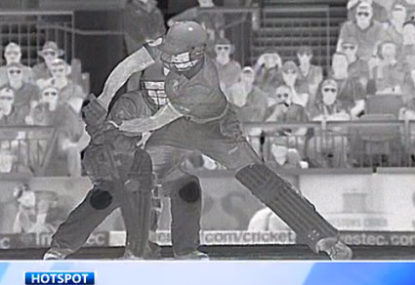With The Ashes set to change hands, maybe even today, it’s time to pause and look a situation within the game that’s becoming farcical.
“…the biggest blight in Test cricket currently is this practice of umpires holding potentially outgoing batsmen on the field while they check for a no-ball,” I wrote twelve months ago, nearly to the day.
“Four dismissals were knocked back … and all of them were no-balls, but the question remains why the umpires are not calling the no-balls as they see them.
“This for me is the issue. The umpires are obviously seeing enough as it happens to think to send the delivery upstairs when a dismissal is on the line. So why don’t they just call the no-ball as they see it?” I wrote, during the Australia-South Africa series last December.
Last year, the major culprit was Asad Rauf, while in the Third Test in Perth currently, both Billy Bowden and Marais Erasmus have delayed outgoing batsmen to check for possible no-balls that in some cases showed more than half the bowler’s foot coming down behind the popping crease.
In the first two Tests, it was Kumar Dharmasena sending everything upstairs, but this isn’t exactly surprising considering he justified sending any potential wicket of Ryan Harris’ upstairs two years ago by explaining at the time he couldn’t see Harris’ front foot landing.
I said it then, and I’ll say it again now: this is cop-out – it’s the umpire’s job to be in the correct position to see the front foot landing.
Likewise, it’s the umpire’s job to be watching the front foot every ball. I say this because it’s becoming increasingly clear that the only way no-balls are called these days is if that delivery takes a wicket.
Early on Day 3, at least three England batsmen were told to wait while potential no-balls were checked.
Two of those showed that the umpire was clearly not watching the front foot in the first place, with an embarrassingly large amount of bowler’s foot grounded well behind the line.
Numerous more balls throughout the course of the Test were shown to be no-balls after the event, and journos and writers at the ground have noticed this, too.
This leads us into yet another DRS drama, with England No.3 Joe Root given out caught behind on the field by Umpire Erasmus on Saturday, and with Root’s immediate referral overturned on account of there not being conclusive enough evidence to prove Erasmus’ original decision was wrong.
Most of the grief around the decision came via Hotspot showing no heat mark, and with ‘Real Time Snicko’ not registering a noise until after the ball had passed the bat.
Remove the Real Time Snicko business, and it’s precisely the same scenario that became of Usman Khawaja at Old Trafford in July.
And so the arguments start. If there’s no mark, then surely he can’t have hit it? If there’s no mark and bat didn’t hit pad, then what was the noise? ‘Snicko’ shows no noise at the supposed moment of impact, so it can’t be out, right?
Well, not necessarily. Because the cricket-watching public has been fooled into thinking or believing that DRS is 100% perfect, it’s been explained to us over time that there will be faint nicks that Hotspot doesn’t pick up.
Likewise, the umpires in this series were briefed prior to the start of the series about Real Time Snicko, and how they should focus particularly on the frame immediately after the ball passes the bat.
“England were left mystified by a third-umpire call that sent Joe Root on his way on the second day at the WACA, but the decision appeared to have been in line with the pre-series instructions to the umpires.”
“The officials were told before the Ashes that sounds detected on the new Real-Time Snickometer could still be an edge even if they appeared to come after the ball had passed the bat, which may have led Tony Hill to uphold the caught-behind decision against Root,” CricInfo reported on Sunday in the aftermath of the Root dismissal.
So just to summarise: Hotspot isn’t hot enough, and Real Time Snicko is slow.
As it is, we have to cop less-than-elite umpires because there are too many Australian and English umps on the ICC Elite Panel. Here’s an idea for that, too; why not just let those elite Australian and English umpires stand in an Ashes series? What’s worse, the perception of possible bias, or evidence of actual incompetence?
Of course, that’s just one of a couple simple fixes that the ICC could implement, if it was seriously in charge of world cricket and not just some honorary body housed in plush offices.
Even if we set aside the argument that the DRS should be dumped and the technology just given to the umpires – an argument I subscribe to, myself – there are two simple fixes that can eradicate these major flaws that have enveloped the game.
Firstly, forget the possibility that faint nicks might be missed, and the allowances for theoretical inaccuracy. If Hotspot sees a mark, just accept it, and give it out. Make it black and white: mark equals out; no mark equals not out. Same goes for Snicko.
Sharp noise equals nick.
Yes, this means that some nicks might be missed, but these would even out over time, and more importantly, we wouldn’t have this ridiculous situation where the system that was created to remove the so-called ‘howler’ is actually creating howlers!
It’s simple, obvious, and consistent.
The other simple fix?
Get the umpires the watch the front bloody foot again!
It’s their job, for goodness sake.





























































































